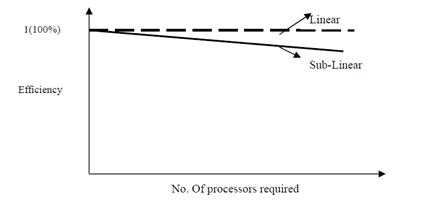Efficiency:-
The other main metric used for performance measurement is efficiency of parallel computer system i.e. how the resources of the parallel systems are being utilized. This is known as degree of effectiveness and the efficiency of a program on a parallel computer with k processors can be defined as the ratio of the relative speed up achieved as shifting the load from one processor machine to k processor machine where the multiple processors are being used for achieving the result in a parallel computer. This is denoted by E(k).
Ek is defined as follows:
E(k) = S (k )/ k
The value of E (k) is directly proportional to S (k) and inversely proportional to number of processors employed for performing the computation. The relation between E (k) vs. Number of processors is shown in Figure.

Efficiency vs. Number of Processors
Assuming we have the multiplication problem as discussed above with k processors, then the efficiency is as under:
E(k) = T(1)/T(n)*K = N/log n*N
E(n) =1/log(n)
Now, supposing we have X processors i.e. X < K and we have to multiply n numbers, in such a condition the processors may be overloaded or might have a few overheads. Then the efficiency is as under:
E(X)= T(1)/T(X)*X
Now, the value of T(X) has to be computed. As we have n numbers, and we have X processors, thus firstly each processor will multiply n/X numbers and consequently process the X partial results on the X processors according to the method discussed in Figure. The time complexity is equal to the sum of the time to compute multiplication of k/X numbers on every processor i.e., O(k/X) and time to compute the answer of partial results i.e. log (X)
E(X) =K/(K/X +log(X))*X
E(X) = (K/X)/(K/X +log(X))
Dividing by X/K we get
E(X) = 1/ (1+(X/K)* log(X))
It can be concluded from the above statement that if N is fixed then the efficiency i.e. E(X) will reduces as the value of X increases and becomes equivalent to E(N) in case X=N. Likewise, if X is fixed then the efficiency i.e., E(X) will increase as the value of X i.e. the number of computations increases.
The other performance metrics engage the standard metrics like MIPS and Mflops. The term MIPS (Million of Instructions Per Second) shows the instruction execution rate. Mflops (Million of Floating Point Operations per Second) shows the floating-point execution rate.